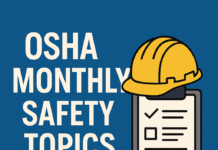
OSHA Safety Engineer: 50 Duties Of A OSHA Safety Engineer
Introduction to OSHA Safety Engineers
Occupational Safety and Health Administration (OSHA) Safety Engineers play a crucial role in fostering safe and healthy work environments. With their expertise in OSHA regulations and safety protocols, these professionals are instrumental in ensuring workplaces adhere to the highest standards of safety.
Significance of OSHA Certification
Before delving into the myriad duties of OSHA Safety Engineers, it’s essential to understand the significance of OSHA certification. OSHA certification ensures that safety engineers possess the necessary knowledge and skills to implement and maintain compliance with OSHA regulations, creating safer workplaces.
Core Responsibilities of an OSHA Safety Engineer
Ensuring Compliance with OSHA Standards
A primary duty of OSHA Safety Engineers is to ensure that workplaces comply with OSHA standards. This involves staying updated on regulatory changes and conducting regular assessments to verify that the organization adheres to the latest safety guidelines.
Conducting Workplace Inspections
OSHA Safety Engineers conduct thorough inspections of workplaces to identify potential hazards. These inspections encompass everything from machinery and equipment to environmental conditions, ensuring a comprehensive assessment of safety risks.
Developing and Implementing Safety Programs
Crafting Effective Safety Policies
One of the foundational duties of OSHA Safety Engineers is the development of clear and effective safety policies. These policies serve as guidelines for employees, outlining best practices, emergency procedures, and safety measures to be followed in the workplace.
Training and Educating Employees
Effective communication of safety policies is crucial. OSHA Safety Engineers are responsible for developing and delivering training programs to educate employees on safety protocols. This includes regular workshops, seminars, and communication channels to keep the workforce informed.
Hazard Identification and Control Measures
Identifying Potential Hazards
OSHA Safety Engineers are skilled in identifying potential hazards within the workplace. This includes assessing risks associated with machinery, chemicals, ergonomics, and other factors that may compromise the safety and well-being of employees.
Implementing Control Strategies
Upon identifying hazards, OSHA Safety Engineers implement control strategies to minimize or eliminate risks. This could involve engineering controls, administrative controls, or the use of personal protective equipment (PPE) to ensure a safe working environment.
Emergency Preparedness and Response
Establishing Emergency Protocols
Preparation for unforeseen events is paramount. OSHA Safety Engineers establish and communicate emergency protocols, ensuring that employees are well-prepared to respond to accidents, natural disasters, or any other emergencies that may arise.
Conducting Drills and Simulations
Regular drills and simulations are organized by OSHA Safety Engineers to test the effectiveness of emergency protocols. This proactive approach ensures that employees are familiar with emergency procedures, facilitating a swift and coordinated response in real-life situations.
Incident Investigation and Reporting
Analyzing Workplace Incidents
In the unfortunate event of a workplace incident, OSHA Safety Engineers play a vital role in conducting thorough investigations. They analyze the root causes, contributing factors, and the effectiveness of existing safety measures to prevent similar incidents in the future.
Documenting Incident Reports
Accurate documentation of incidents is essential for learning from past experiences. OSHA Safety Engineers ensure that all workplace incidents are thoroughly documented, providing valuable data for analysis and future reference.
Safety Audits and Inspections
Regular Audits for Compliance
To ensure ongoing adherence to safety standards, OSHA Safety Engineers conduct regular safety audits. These audits assess compliance with OSHA regulations and internal safety policies, identifying areas that may need improvement.
Addressing Non-compliance Issues
If any non-compliance issues are identified during audits, OSHA Safety Engineers take prompt action to address them. This may involve implementing corrective measures, providing additional training, or updating existing safety protocols to align with regulatory requirements.
Collaborating with Stakeholders
Working with Management
Effective collaboration with management is crucial for implementing comprehensive safety measures. OSHA Safety Engineers work closely with organizational leadership to align safety initiatives with overall business goals and objectives.
Engaging Employees and Unions
Collaboration extends to engaging employees and unions in the safety process. OSHA Safety Engineers foster a culture of safety by involving workers in safety programs, seeking their input, and addressing concerns raised by unions to create a safer and more inclusive work environment.
Environmental Health and Safety
Assessing Environmental Risks
Beyond workplace safety, OSHA Safety Engineers assess and mitigate environmental risks. This includes identifying factors that may impact the environment and implementing measures to minimize the organization’s ecological footprint.
Promoting Sustainable Practices
OSHA Safety Engineers play a role in promoting sustainability within the workplace. They recommend and implement practices that reduce the environmental impact of the organization, aligning with global efforts for a greener and safer world.
Personal Protective Equipment (PPE)
Assessing PPE Requirements
OSHA Safety Engineers assess the specific personal protective equipment (PPE) requirements for different roles within the organization. This includes evaluating the effectiveness of existing PPE and recommending upgrades or changes as needed.
Ensuring Proper Usage
Providing PPE is only part of the equation; ensuring its proper usage is equally important. OSHA Safety Engineers educate employees on the correct use of protective gear and monitor compliance to maximize its effectiveness.
Continuous Improvement Strategies
Analyzing Safety Metrics
OSHA Safety Engineers continuously analyze safety performance metrics. This involves reviewing incident reports, audit findings, and employee feedback to identify areas for improvement and implement proactive measures.
Implementing Feedback Mechanisms
Feedback is a valuable tool for ongoing improvement. OSHA Safety Engineers establish mechanisms for collecting feedback from employees, incorporating their insights into safety initiatives and fostering a culture of continuous improvement.
An OSHA (Occupational Safety and Health Administration) Safety Engineer is responsible for ensuring compliance with OSHA regulations and fostering a safe work environment. Here are 50 duties that an OSHA Safety Engineer may perform:- Interpret and enforce OSHA regulations.
- Conduct workplace inspections to identify safety hazards.
- Develop and implement safety programs.
- Provide OSHA compliance training to employees.
- Investigate accidents and incidents to determine OSHA violations.
- Maintain records of workplace injuries and illnesses.
- Ensure the proper use of personal protective equipment (PPE).
- Conduct hazard assessments and develop control measures.
- Advise management on OSHA compliance matters.
- Develop and implement emergency response plans.
- Monitor air quality and exposure to hazardous substances.
- Conduct noise level monitoring and implement controls.
- Inspect and approve safety equipment.
- Review and update safety policies and procedures.
- Conduct safety meetings and training sessions.
- Participate in OSHA inspections and respond to findings.
- Develop and maintain Material Safety Data Sheets (MSDS).
- Implement lockout/tagout procedures.
- Ensure compliance with confined space entry requirements.
- Investigate complaints related to OSHA violations.
- Develop and maintain safety signage and labels.
- Monitor compliance with machine guarding requirements.
- Oversee the implementation of a respiratory protection program.
- Conduct ergonomic assessments and recommend improvements.
- Implement and manage a permit-to-work system.
- Review and approve safety-related budgets.
- Collaborate with other departments to address safety concerns.
- Conduct training on OSHA recordkeeping requirements.
- Monitor compliance with fall protection standards.
- Evaluate and recommend improvements for workplace lighting.
- Oversee the handling and storage of hazardous materials.
- Develop and implement a fire prevention plan.
- Review and approve safety plans for construction projects.
- Conduct electrical safety inspections.
- Monitor compliance with OSHA’s bloodborne pathogens standard.
- Implement and manage a process safety management program.
- Provide guidance on OSHA compliance for new projects.
- Investigate and report on near misses.
- Conduct respirator fit testing and training.
- Ensure compliance with OSHA’s Hazard Communication Standard.
- Evaluate the effectiveness of safety committees.
- Review and approve contractor safety plans.
- Conduct safety audits and risk assessments.
- Monitor compliance with OSHA’s electrical safety standards.
- Develop and implement safety incentives and recognition programs.
- Conduct safety drills and emergency evacuation exercises.
- Participate in the development of safety policies.
- Evaluate the effectiveness of safety training programs.
- Collaborate with healthcare professionals on employee wellness.
- Stay updated on changes in OSHA regulations and industry best practices.
These duties are representative, and the specific responsibilities may vary based on the industry, organization, and job role of the OSHA Safety Engineer.Conclusion
In conclusion, OSHA Safety Engineers shoulder a myriad of responsibilities to create and maintain safe workplaces. From crafting policies to engaging with stakeholders, these professionals play a pivotal role in ensuring compliance with safety standards and fostering a culture of safety. With their dedication to continuous improvement, OSHA Safety Engineers contribute significantly to the well-being of employees and the overall success of organizations.
How to Check OSHA Accreditation
How to Become an OSHA Approved Trainer
How to Register for OSHA Training Certification Program
OSHA Safety Manager: OSHA Certified Safety Manager Salary
OSHA Safety Engineer: OSHA Certified Safety Engineer Salary
FAQs
- What is OSHA certification, and why is it crucial for safety engineers? OSHA certification is provided by the Occupational Safety and Health Administration, ensuring safety engineers are well-versed in regulations and protocols. It is crucial for professionals in the field to ensure workplaces adhere to the highest safety standards.
- How often should safety audits be conducted in an organization? Safety audits should be conducted regularly, at least annually, to assess compliance with OSHA regulations and internal safety policies. Regular audits help identify areas for improvement and ensure ongoing adherence to safety standards.
- How do OSHA Safety Engineers promote environmental sustainability in the workplace? OSHA Safety Engineers assess and mitigate environmental risks, recommending and implementing practices that reduce the organization’s ecological footprint. They play a role in promoting sustainability within the workplace.
- What role do OSHA Safety Engineers play in emergency preparedness? OSHA Safety Engineers play a vital role in establishing emergency protocols and conducting drills to ensure employees are well-prepared to respond to accidents, natural disasters, or any other emergencies that may arise.
- How can OSHA Safety Engineers foster a culture of safety within an organization? OSHA Safety Engineers foster a culture of safety by collaborating with management, engaging employees and unions, and involving workers in safety programs. They seek feedback, address concerns, and actively involve all stakeholders in the safety process.
























